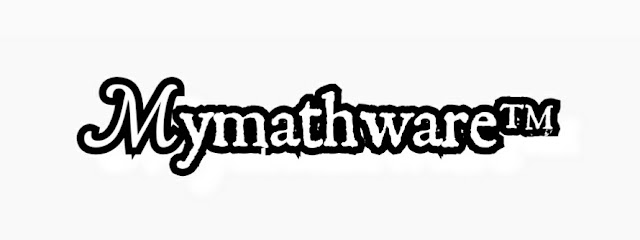Solution To Problems of Convergence Sequence using Epsilon Approach
In one of my previous post titled "The convergence Sequence" i discussed about how to identify sequences that are convergent and also gave an example of how to solve a sequence that approaches or converges to a particular limit using a very simple method of limit at infinity.
Below i will be solving some sequence problems using another method of convergent sequence known as the "epsilon or limit approach".
Below i will be solving some sequence problems using another method of convergent sequence known as the "epsilon or limit approach".
Example 1
prove that $\lim_{n\rightarrow\infty}\frac{n}{n+1}=1$
prove that $\lim_{n\rightarrow\infty}\frac{n}{n+1}=1$
Solution: using epsilon or limits definition of convergency which says that for all $\epsilon>0$ there is a natural number $\mathbb{N}$ such that $|s_n-L|<\epsilon$ for all $n\geq{\mathbb{N}(\epsilon)}$.
Now let $s_n=\frac{n}{n+1}$ and $L=1$ then \begin{align*}
&=|\frac{n}{n+1}-1|<\epsilon\\
&=|\frac{n-(n+1)}{n+1}|<\epsilon\\
&=|\frac{-1}{n+1}|<\epsilon\\
&=\frac{1}{n+1}<\epsilon
\end{align*}
since $\epsilon>0$ and it is a very small positive unknown number we let $\epsilon=\frac{1}{n}$ so that
$\frac{1}{n+1}<\frac{1}{n}$ and we must still note that $\frac{1}{n}<\epsilon$ subsequently $n>\frac{1}{\epsilon}$ now since $n\geq{\mathbb{N}(\epsilon)}$ then we can finalise our answer as \begin{align*}
\mathbb{N}(\epsilon)=[\frac{1}{\epsilon}+1]
\end{align*}
therefore $\mathbb{N}(\epsilon):|s_n-L|<\epsilon$ for all $n\geq{\mathbb{N}(\epsilon)}:[\frac{1}{\epsilon}+1]$
Now let $s_n=\frac{n}{n+1}$ and $L=1$ then \begin{align*}
&=|\frac{n}{n+1}-1|<\epsilon\\
&=|\frac{n-(n+1)}{n+1}|<\epsilon\\
&=|\frac{-1}{n+1}|<\epsilon\\
&=\frac{1}{n+1}<\epsilon
\end{align*}
since $\epsilon>0$ and it is a very small positive unknown number we let $\epsilon=\frac{1}{n}$ so that
$\frac{1}{n+1}<\frac{1}{n}$ and we must still note that $\frac{1}{n}<\epsilon$ subsequently $n>\frac{1}{\epsilon}$ now since $n\geq{\mathbb{N}(\epsilon)}$ then we can finalise our answer as \begin{align*}
\mathbb{N}(\epsilon)=[\frac{1}{\epsilon}+1]
\end{align*}
therefore $\mathbb{N}(\epsilon):|s_n-L|<\epsilon$ for all $n\geq{\mathbb{N}(\epsilon)}:[\frac{1}{\epsilon}+1]$
Example 2
Prove that $\lim_{n\rightarrow{\infty}}\frac{1}{n^2}=0$
Prove that $\lim_{n\rightarrow{\infty}}\frac{1}{n^2}=0$
Solution: we are being asked to show that the given sequence approaches zero(0) as the limit n approaches $infinity(\infty)$.
using the epsilon or limit approach,let the sequence $s_n=\frac{1}{n^2}$ and the limit $L=0$ so that when we substitute inside the limit formula we get
\begin{align*}
&|s_n-L|<\epsilon\\
&=|\frac{1}{n^2}-0|<\epsilon\\
&=|\frac{1}{n^2}|<\epsilon\\
&=\frac{1}{n^2}<\epsilon
\end{align*}
since the epsilon is a very small positive unknown number we let
$\epsilon=\frac{1}{n}$ such that $\frac{1}{n^2}<\frac{1}{n}$ where $n=2$ now $\frac{1}{n}<\epsilon$ make n subject of formula such that $n>\frac{1}{\epsilon}$ now since we know by definition that $n\geq{\mathbb{N}(\epsilon)}$
therefore $\mathbb{N}(\epsilon):=[\frac{1}{\epsilon}+1]$ which is the convergency of the sequence.
using the epsilon or limit approach,let the sequence $s_n=\frac{1}{n^2}$ and the limit $L=0$ so that when we substitute inside the limit formula we get
\begin{align*}
&|s_n-L|<\epsilon\\
&=|\frac{1}{n^2}-0|<\epsilon\\
&=|\frac{1}{n^2}|<\epsilon\\
&=\frac{1}{n^2}<\epsilon
\end{align*}
since the epsilon is a very small positive unknown number we let
$\epsilon=\frac{1}{n}$ such that $\frac{1}{n^2}<\frac{1}{n}$ where $n=2$ now $\frac{1}{n}<\epsilon$ make n subject of formula such that $n>\frac{1}{\epsilon}$ now since we know by definition that $n\geq{\mathbb{N}(\epsilon)}$
therefore $\mathbb{N}(\epsilon):=[\frac{1}{\epsilon}+1]$ which is the convergency of the sequence.
Example 3
Show that $\lim_{n\rightarrow\infty}\frac{3n+1}{7n-4}=\frac{3}{7}$
Solution:
$\lim_{n\rightarrow\infty}\frac{3n+1}{7n-4}=\frac{3}{7}$ meaning the sequence $\frac{3n+1}{7n-4}$ converges to $\frac{3}{7}$ as the limit n approaches infinity.
By definition of convergency we know that every convergent sequence must satisfy $\mathbb{N}(\epsilon):|s_n-L|<\epsilon$ for every $\epsilon>0$ and $n\geq{\mathbb{N}(\epsilon)}$ Let $s_n=\frac{3n+1}{7n-4}$ and $L=\frac{3}{7}$
\begin{align*}
|\frac{3n+1}{7n-4}-\frac{3}{7}|<\epsilon
\end{align*}
take the L.C.M of the denominator which $7(7n-4)$,
Show that $\lim_{n\rightarrow\infty}\frac{3n+1}{7n-4}=\frac{3}{7}$
Solution:
$\lim_{n\rightarrow\infty}\frac{3n+1}{7n-4}=\frac{3}{7}$ meaning the sequence $\frac{3n+1}{7n-4}$ converges to $\frac{3}{7}$ as the limit n approaches infinity.
By definition of convergency we know that every convergent sequence must satisfy $\mathbb{N}(\epsilon):|s_n-L|<\epsilon$ for every $\epsilon>0$ and $n\geq{\mathbb{N}(\epsilon)}$ Let $s_n=\frac{3n+1}{7n-4}$ and $L=\frac{3}{7}$
\begin{align*}
|\frac{3n+1}{7n-4}-\frac{3}{7}|<\epsilon
\end{align*}
take the L.C.M of the denominator which $7(7n-4)$,
\begin{align*}
&|\frac{7(3n+1)-3(7n-4)}{7(7n-4)}|<\epsilon\\
&=|\frac{21n+7-21n+12}{7(7n-4)}|<\epsilon\\
&=|\frac{19}{7(7n-4)}|<\epsilon\\
&=\frac{19}{7(7n-4)}<\epsilon
\end{align*}
multiply $\frac{1}{2}$ by what carries "n" in the denominator such it is greater than the constant number i.e $\frac{7n}{2}>4$.
\begin{align*}
\frac{19}{7(7n-4)}<\frac{19}{7(7n-\frac{7n}{2})}
\end{align*}
$\frac{7n}{2}>4$ if n=2 we get $7>4$
\begin{align*}
&\frac{19}{7(7n-\frac{7n}{2})}\\
&=\frac{19}{7(\frac{14n-7n}{2})}\\
&=\frac{38}{49n}<\epsilon\\
&=n>\frac{38}{49\epsilon}
\end{align*}
But remember that $\frac{7n}{2}>4=7n>8\Rightarrow{n}>\frac{8}{7}$
Since $n\geq{\mathbb{N}(\epsilon)}$ therefore
\begin{align*}
n\geq{\mathbb{N}(\epsilon)}:=max\{(\frac{8}{7}+1)(\frac{38}{49\epsilon}+1)\}
\end{align*}
the covergency is proved, the answer is maximum because two values of $n$ was obtained at the end of the solution.
Play Question
Show whether or not $\lim_{n\rightarrow\infty}\frac{(-1)^n}{n}=0$ is convergent using any method possible.
&|\frac{7(3n+1)-3(7n-4)}{7(7n-4)}|<\epsilon\\
&=|\frac{21n+7-21n+12}{7(7n-4)}|<\epsilon\\
&=|\frac{19}{7(7n-4)}|<\epsilon\\
&=\frac{19}{7(7n-4)}<\epsilon
\end{align*}
multiply $\frac{1}{2}$ by what carries "n" in the denominator such it is greater than the constant number i.e $\frac{7n}{2}>4$.
\begin{align*}
\frac{19}{7(7n-4)}<\frac{19}{7(7n-\frac{7n}{2})}
\end{align*}
$\frac{7n}{2}>4$ if n=2 we get $7>4$
\begin{align*}
&\frac{19}{7(7n-\frac{7n}{2})}\\
&=\frac{19}{7(\frac{14n-7n}{2})}\\
&=\frac{38}{49n}<\epsilon\\
&=n>\frac{38}{49\epsilon}
\end{align*}
But remember that $\frac{7n}{2}>4=7n>8\Rightarrow{n}>\frac{8}{7}$
Since $n\geq{\mathbb{N}(\epsilon)}$ therefore
\begin{align*}
n\geq{\mathbb{N}(\epsilon)}:=max\{(\frac{8}{7}+1)(\frac{38}{49\epsilon}+1)\}
\end{align*}
the covergency is proved, the answer is maximum because two values of $n$ was obtained at the end of the solution.
Play Question
Show whether or not $\lim_{n\rightarrow\infty}\frac{(-1)^n}{n}=0$ is convergent using any method possible.







0 Comments
Comments